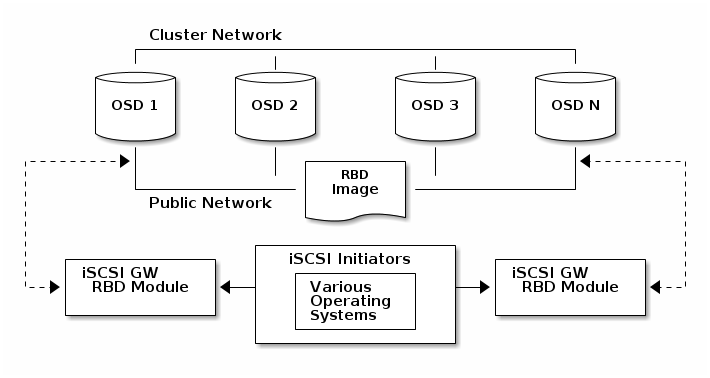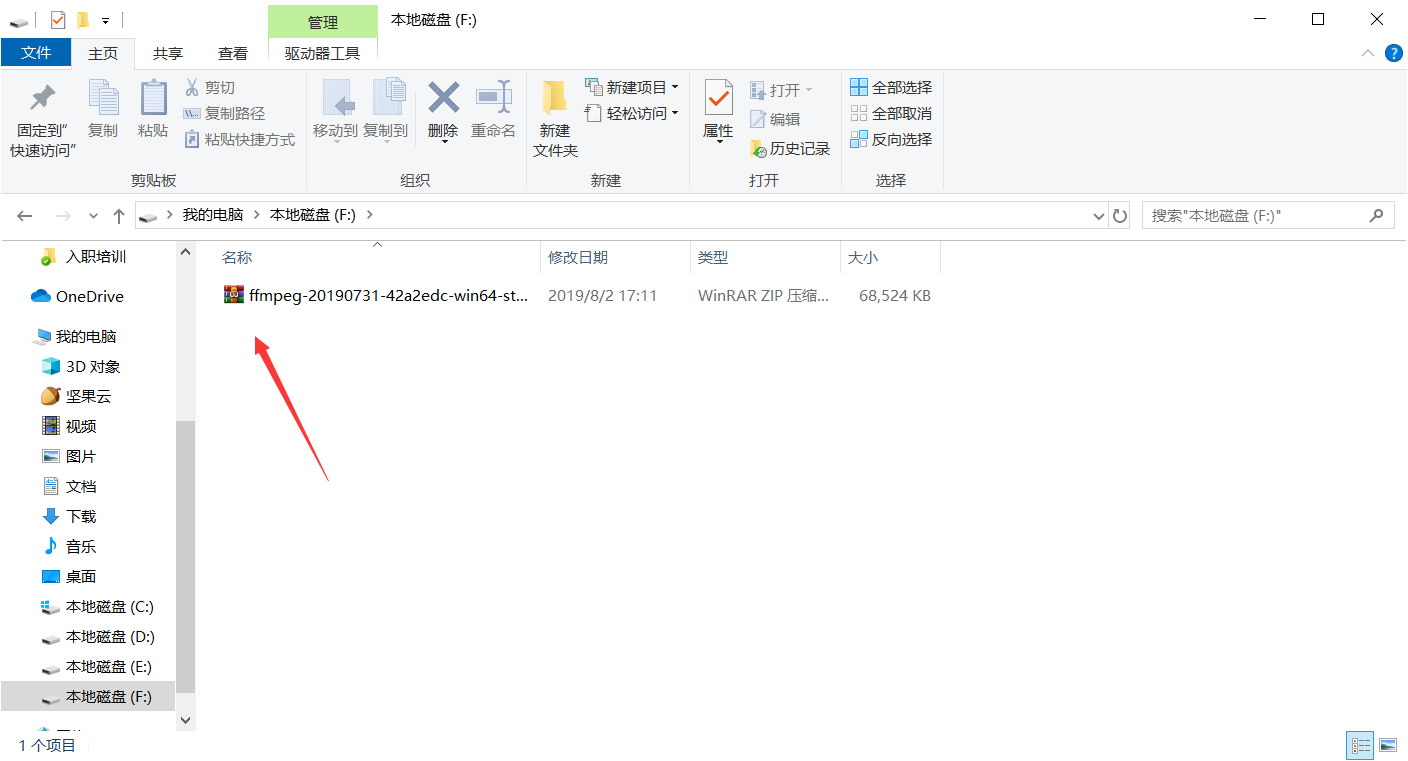ceph iscsi安装
2020-02-24
#安装包
- 下载包https://github.com/ceph/ceph-iscsi
- 安装ceph-iscsi配置文件
- 安装rbd-target-api所在的ceph-iscsi-cli包
3.1安装依赖python-configshell,网上
3.2安装包里的python-rtslib(先卸载老版本)
3.3安装包里的ceph-iscsi-config - 安装ceph-iscsi-tools
4.1安装依赖python-pcp,网上
4.2安装依赖pcp-pmda-lio,网上
5.安装libtcmu
6.安装targetcli
6.1安装python-ethtool,网上
7.安装tcmu-runner
8.配置/etc/ceph/iscsi-gateway.cfg
#配置
- iscsi-gateway的api端口可能要改,默认是5000
- gatway数目也可以iscsi-gateway配置文件中修改minimum_gateways,默认为2
- 创建target的时候必须要主机名和ip
- 创建好cinder配置后端所需要的池,比如iscsi池
- 启动rbd-target-api
- target在iscsi-gateway配置文件可以通过ceph_pool,配置gateway.conf文件所在的池
- target在iscsi-gateway配置文件可以通过api_ip,配置rbd-target-api所监听的ip
注意
- 不同的driver的target名字不能一样
- configfs的内容重启可以删除
3.计算节点要安装iscsid,并配置用户名和密码 - 替换自己修改的/usr/bin/rbd-target-api文件
- 可以配置ceph_config_dir设置ceph配置路径
需要修改1 settings文件前提准备
首先看到ceph官网给出的大体结构:

大体结构
可以看到主要分为ceph集群、rbd、iscsi网关、initiator(也就是客户端)构成。
那么所需的准备就如下:
一个HEALTH_OK的ceph集群,还有剩余的存储空间(给创建的rbd使用)。这里是我所搭建的集群:
1 2 3 4 5 6 7 8 9 10 11 12 13 14 15 16 17
$ sudo ceph -scluster:id: 51e9f534-b15a-4273-953c-9b56e9312510health: HEALTH_OKservices:mon: 3 daemons, quorum node1,node2,node3mgr: node1(active), standbys: node2, node3mds: cephfs-1/1/1 up {0=node1=up:active}osd: 6 osds: 6 up, 6 indata:pools: 2 pools, 64 pgsobjects: 508 objects, 1.9 GiBusage: 26 GiB used, 6.0 TiB / 6.0 TiB availpgs: 64 active+clean两台linux主机,作为iscsi网关,可以是集群中的主机。
一台linux主机,作为linux系统下的客户端。
一台windows主机,作为windows系统下的客户端。
配置ceph-iscsi网关
修改osd配置
安装官网所述,先修改osd的配置:
1 2 3
[osd] osd heartbeat grace = 20 osd heartbeat interval = 5
将上述配置添加到所有ceph节点的
/etc/ceph/ceph.conf文件中, 当然可以使用ceph-deploy来推送。1 2 3 4 5 6 7 8 9 10 11 12 13 14 15 16 17
$ vim ceph.conf $ cat ceph.conf[global] fsid = 51e9f534-b15a-4273-953c-9b56e9312510 mon_initial_members = node1, node2, node3 mon_host = 192.168.90.233,192.168.90.234,192.168.90.235 auth_cluster_required = cephx auth_service_required = cephx auth_client_required = cephx public_network = 192.168.0.0/16[osd] osd heartbeat grace = 20 osd heartbeat interval = 5$ ceph-deploy --overwrite-conf config push node1 node2 node3
下载所需要的相关rpm包
这里直接选择Using the Command Line Interface,感觉这个更靠谱一些。
按照官网所述,yum的repo中需要有以下rpm包:

所需rpm包
直接
yum install试试可以发现,只有targetcli和python-rtslib能装上,而且版本都比官网说的要低,好吧,麻烦来了。经过一段几个小时*的搜索……从下面链接中找到了rpm包:
Build new RPM for 3.0 Missing ceph-iscsi-cli package新建repo文件:
1 2 3 4 5 6 7 8 9 10 11 12 13 14 15 16 17 18 19 20
$ sudo vim /etc/yum.repo.d/iscsi.repo $ cat /etc/yum.repo.d/iscsi.repo[ceph-iscsi] name=Ceph-iscsi baseurl=https://4.chacra.ceph.com/r/ceph-iscsi/master/88f3f67981c7da15448f140f711a1a8413d450b0/centos/7/flavors/default/noarch/ priority=1 gpgcheck=0[tcmu-runner] name=tcmu-runner baseurl=https://3.chacra.ceph.com/r/tcmu-runner/master/eef511565078fb4e2ed52caaff16e6c7e75ed6c3/centos/7/flavors/default/x86_64/ priority=1 gpgcheck=0[python-rtslib] name=python-rtslib baseurl=https://2.chacra.ceph.com/r/python-rtslib/master/67eb1605c697b6307d8083b2962f5170db13d306/centos/7/flavors/default/noarch/ priority=1 gpgcheck=0
这里我使用的是本地源,将上面的包下载到本地源:
1 2
$ sudo yum install --downloadonly --downloaddir=yum/ceph-iscsi/ targetcli python-rtslib tcmu-runner ceph-iscsi $ createrepo -p -d -o yum/ yum/
注意到这里没有包含targetcli的repo,因为没有找到,使用yum基础的Base源或者是Ceph源可以安装
targetcli-2.1.fb46-7.el7.noarch.rpm, 虽然官网需要的是targetcli-2.1.fb47 or newer package,但在后续使用中发现没有影响,所以这里就不用管targetcli了。那么这里下载下来的就是:
targetcli-2.1.fb46-7.el7.noarch.rpm python-rtslib-2.1.fb68-1.noarch.rpm tcmu-runner-1.4.0-0.1.51.geef5115.el7.x86_64.rpm ceph-iscsi-3.2-8.g88f3f67.el7.noarch.rpmceph-iscsi网关初始配置
如果使用的不是集群内的节点作为ceph-iscsi网关,那就需要进行一些初始的配置。
安装ceph。 从集群中的一台机器上拷贝/etc/ceph/ceph.conf到本机的/etc/ceph/ceph.conf。 从集群中的一台机器上拷贝/etc/ceph/ceph.client.admin.keyring到本机的/etc/ceph/ceph.client.admin.keyring。当然第2和3步可以直接在deploy节点使用
ceph-deploy admin {node-gateway},{node-gateway}就表示网关节点的名字。可见这里就是为了将ceph-iscsi网关节点变成一个admin节点。
这时在网关节点上应该可以执行相关命令操作ceph集群,例如
sudo ceph -s查询当前集群的状态。安装配置iscsi
这里官网建议先切换到root用户,方便一点:
1
$ su root
在两个网关节点上都安装iscsi(注意到上面已经将相关包下载到了本地源,所以可以直接yum安装):
1
# yum install -y ceph-iscsi
服务启动:
先创建
rbd pool,如果没有的话。1 2 3 4 5 6 7 8
# ceph osd lspools1 cephfs_data 2 cephfs_metadata# ceph osd pool create rbd 128pool 'rbd' created
创建并修改
/etc/ceph/iscsi-gateway.cfg文件:1 2 3 4 5 6 7 8 9 10 11 12 13 14 15 16 17 18 19 20 21 22 23 24 25 26 27 28 29 30 31
# vim /etc/ceph/iscsi-gateway.cfg # cat /etc/ceph/iscsi-gateway.cfg[config] # Name of the Ceph storage cluster. A suitable Ceph configuration file allowing # access to the Ceph storage cluster from the gateway node is required, if not # colocated on an OSD node. cluster_name = ceph# Place a copy of the ceph cluster's admin keyring in the gateway's /etc/ceph # drectory and reference the filename here gateway_keyring = ceph.client.admin.keyring# API settings. # The API supports a number of options that allow you to tailor it to your # local environment. If you want to run the API under https, you will need to # create cert/key files that are compatible for each iSCSI gateway node, that is # not locked to a specific node. SSL cert and key files *must* be called # 'iscsi-gateway.crt' and 'iscsi-gateway.key' and placed in the '/etc/ceph/' directory # on *each* gateway node. With the SSL files in place, you can use 'api_secure = true' # to switch to https mode.# To support the API, the bear minimum settings are: api_secure = false# Additional API configuration options are as follows, defaults shown. # api_user = admin # api_password = admin # api_port = 5001 trusted_ip_list = 192.168.90.234,192.168.90.235
上面
trusted_ip_list填写的就是两台网关的ip(这里不讨论多网卡的情况)。在另外一台网关上复制这个文件:
1
$ sudo scp cluster@node2:/etc/ceph/iscsi-gateway.cfg /etc/ceph/iscsi-gateway.cfg
在两台网关上都开启rbd-target-api服务:
1 2 3
# systemctl daemon-reload # systemctl enable rbd-target-api # systemctl start rbd-target-api
配置:(在其中一台网关配置就行)
1 2 3 4 5 6 7 8 9 10 11 12 13 14 15 16 17 18 19 20 21 22 23 24 25 26 27 28 29 30 31
# gwcli /> cd /iscsi-targets/iscsi-targets> create iqn.2003-01.com.redhat.iscsi-gw:iscsi-igw ok/iscsi-targets> cd iqn.2003-01.com.redhat.iscsi-gw:iscsi-igw/gateways/iscsi-target...-igw/gateways> create node2 192.168.90.234 Adding gateway, sync'ing 0 disk(s) and 0 client(s) ok/iscsi-target...-igw/gateways> create node3 192.168.90.235 Adding gateway, sync'ing 0 disk(s) and 0 client(s) ok/iscsi-target...-igw/gateways> cd /disks/disks> create pool=rbd image=disk_1 size=200G ok/disks> cd /iscsi-targets/iqn.2003-01.com.redhat.iscsi-gw:iscsi-igw/hosts/iscsi-target...csi-igw/hosts> create iqn.1994-05.com.redhat:rh7-client ok/iscsi-target...at:rh7-client> auth username=myiscsiusername password=myiscsipassword ok/iscsi-target...at:rh7-client> disk add rbd/disk_1 ok
配置完成,可以看到我当前的目录结构:
1 2 3 4 5 6 7 8 9 10 11 12 13 14 15 16 17 18 19 20 21 22 23
/> ls o- / ......................................................................... [...]o- cluster ......................................................... [Clusters: 1]| o- ceph .......................................................... [HEALTH_WARN]| o- pools .......................................................... [Pools: 3]| | o- cephfs_data ... [(x3), Commit: 0.00Y/2028052096K (0%), Used: 2029431878b]| | o- cephfs_metadata .... [(x3), Commit: 0.00Y/2028052096K (0%), Used: 77834b]| | o- rbd ................ [(x3), Commit: 200G/2028052096K (10%), Used: 15352b]| o- topology ................................................ [OSDs: 6,MONs: 3]o- disks ........................................................ [200G, Disks: 1]| o- rbd ............................................................ [rbd (200G)]| o- disk_1 ................................................ [rbd/disk_1 (200G)]o- iscsi-targets ............................... [DiscoveryAuth: None, Targets: 1]o- iqn.2003-01.com.redhat.iscsi-gw:iscsi-igw ..................... [Gateways: 2]o- disks .......................................................... [Disks: 1]| o- rbd/disk_1 ............................................... [Owner: node3]o- gateways ............................................ [Up: 2/2, Portals: 2]| o- node2 ............................................. [192.168.90.234 (UP)]| o- node3 ............................................. [192.168.90.235 (UP)]o- host-groups .................................................. [Groups : 0]o- hosts .............................................. [Hosts: 1: Auth: CHAP]o- iqn.1994-05.com.redhat:rh7-client .......... [Auth: CHAP, Disks: 1(200G)]o- lun 0 ................................ [rbd/disk_1(200G), Owner: node3]
linux客户端配置
在作为客户端的linux主机上。
安装相关组件:
1 2
$ sudo yum install -y iscsi-initiator-utils $ sudo yum install -y device-mapper-multipath
开启multipathd服务并进行配置:
1 2 3 4 5 6 7 8 9 10 11 12 13 14 15 16 17 18 19
$ sudo mpathconf --enable --with_multipathd y$ sudo vim /etc/multipath.conf $ sudo cat /etc/multipath.confdevices {device {vendor "LIO-ORG"hardware_handler "1 alua"path_grouping_policy "failover"path_selector "queue-length 0"failback 60path_checker turprio aluaprio_args exclusive_pref_bitfast_io_fail_tmo 25no_path_retry queue} }修改客户端名称:
1 2 3 4
$ sudo vim /etc/iscsi/initiatorname.iscsi $ sudo cat /etc/iscsi/initiatorname.iscsiInitiatorName=iqn.1994-05.com.redhat:rh7-client
修改chap认证配置文件:
1 2 3 4 5 6 7 8 9 10 11 12 13 14 15 16 17 18
$ sudo vim /etc/iscsi/iscsid.conf $ sudo cat /etc/iscsi/iscsid.conf... # ************* # CHAP Settings # *************# To enable CHAP authentication set node.session.auth.authmethod # to CHAP. The default is None. node.session.auth.authmethod = CHAP# To set a CHAP username and password for initiator # authentication by the target(s), uncomment the following lines: node.session.auth.username = myiscsiusername node.session.auth.password = myiscsipassword ...
发现target:
1 2 3 4
$ sudo iscsiadm -m discovery -t st -p 192.168.90.234192.168.90.234:3260,1 iqn.2003-01.org.linux-iscsi.rheln1 192.168.90.235:3260,2 iqn.2003-01.org.linux-iscsi.rheln1
登入target:
1
$ sudo iscsiadm -m node -T iqn.2003-01.org.linux-iscsi.rheln1 -l
查看是否成功:
1 2 3 4 5 6 7
$ sudo multipath -ll mpatha (360014050fedd563975249adb2e84e978) dm-2 LIO-ORG ,TCMU device size=200G features='1 queue_if_no_path' hwhandler='1 alua' wp=rw |-+- policy='queue-length 0' prio=50 status=active | `- 3:0:0:0 sdc 8:32 active ready running `-+- policy='queue-length 0' prio=10 status=enabled`- 2:0:0:0 sdb 8:16 active ready running
在fdisk中就可以直接看到这个“硬盘”:
1 2 3 4 5 6 7 8
$ sudo fdisk -l... Disk /dev/mapper/mpatha: 10.7 GB, 10737418240 bytes, 20971520 sectors Units = sectors of 1 * 512 = 512 bytes Sector size (logical/physical): 512 bytes / 512 bytes I/O size (minimum/optimal): 512 bytes / 524288 bytes ...
windows客户端配置
在
控制面板->管理工具->iSCSI 发起程序:
控制面板->管理工具

管理工具->iSCSI 发起程序
修改发起程序名称:

发起程序名称
添加发现目标门户:
添加发现目标门户
可以看到出现目标:
出现目标
连接到该目标:

连接目标
修改高级设置:

修改高级设置
可以看到已连接:

可以看到已连接
可以在磁盘管理中看到硬盘已经连接:

磁盘管理
这里将它分为F盘,并且成功往里面放了一个文件:

分配成为F盘

放入文件成功
Health Warning
注意到此时ceph集群可能会出现一个
Health Warning:1 2 3 4 5 6 7 8 9 10 11 12 13 14 15 16 17 18 19 20 21 22
$ sudo ceph -scluster:id: 51e9f534-b15a-4273-953c-9b56e9312510health: HEALTH_WARNapplication not enabled on 1 pool(s)services:mon: 3 daemons, quorum node1,node2,node3mgr: node1(active), standbys: node2, node3mds: cephfs-1/1/1 up {0=node1=up:active}osd: 6 osds: 6 up, 6 intcmu-runner: 2 daemons activedata:pools: 3 pools, 192 pgsobjects: 559 objects, 2.1 GiBusage: 27 GiB used, 6.0 TiB / 6.0 TiB availpgs: 192 active+cleanio:client: 2.5 KiB/s rd, 2 op/s rd, 0 op/s wr从官网中可以看到这个warning发生的原因New in Luminous: pool tags, 另外使用
ceph health detail也可以看到解决方法:1 2 3 4 5 6
$ sudo ceph health detailHEALTH_WARN application not enabled on 1 pool(s) POOL_APP_NOT_ENABLED application not enabled on 1 pool(s)application not enabled on pool 'rbd'use 'ceph osd pool application enable <pool-name> <app-name>', where <app-name> is 'cephfs', 'rbd', 'rgw', or freeform for custom applications.
这里就将所建立的
rbd池标记为rbd:1 2 3 4 5 6 7 8 9 10 11 12 13 14 15 16 17 18 19 20 21 22 23 24 25
$ sudo ceph osd pool application enable rbd rbdenabled application 'rbd' on pool 'rbd'$ sudo ceph -scluster:id: 51e9f534-b15a-4273-953c-9b56e9312510health: HEALTH_OKservices:mon: 3 daemons, quorum node1,node2,node3mgr: node1(active), standbys: node2, node3mds: cephfs-1/1/1 up {0=node1=up:active}osd: 6 osds: 6 up, 6 intcmu-runner: 2 daemons activedata:pools: 3 pools, 192 pgsobjects: 559 objects, 2.1 GiBusage: 27 GiB used, 6.0 TiB / 6.0 TiB availpgs: 192 active+cleanio:client: 2.0 KiB/s rd, 1 op/s rd, 0 op/s wr问题解决。
需要修改2 /usr/lib/python2.7/site-packages/gwcli/ceph.py
| |
| |
上面的修改涉及到ceph-iscsi-cli和ceph-iscsi-config
- gateway ha配置
6.1 首先在每个节点安装包,然后配置/etc/ceph/iscsi-gateway.cfg,把ip都加上
6.2 在某一个节点使用gwcli创建gateway
6.3 创建gateway之后会自动同步
6.4 在为创建gwcli之前,这个节点的gwcli命令是不可用的
cinder的参考配置如下
| |
multipath配置
| |
多路径配置
-
nova的compute配置文件要在libvirt section下面增加
1volume_use_multipath = True -
安装multipathd
1 2 3 4yum install device-mapper-multipath mpathconf --enable systemctl restart multipathd.service systemctl enable multipathd.service
| |
内核模块支持
tcmu-runner需要加载内核模块target_core_user,这文件路径在
| |











)







